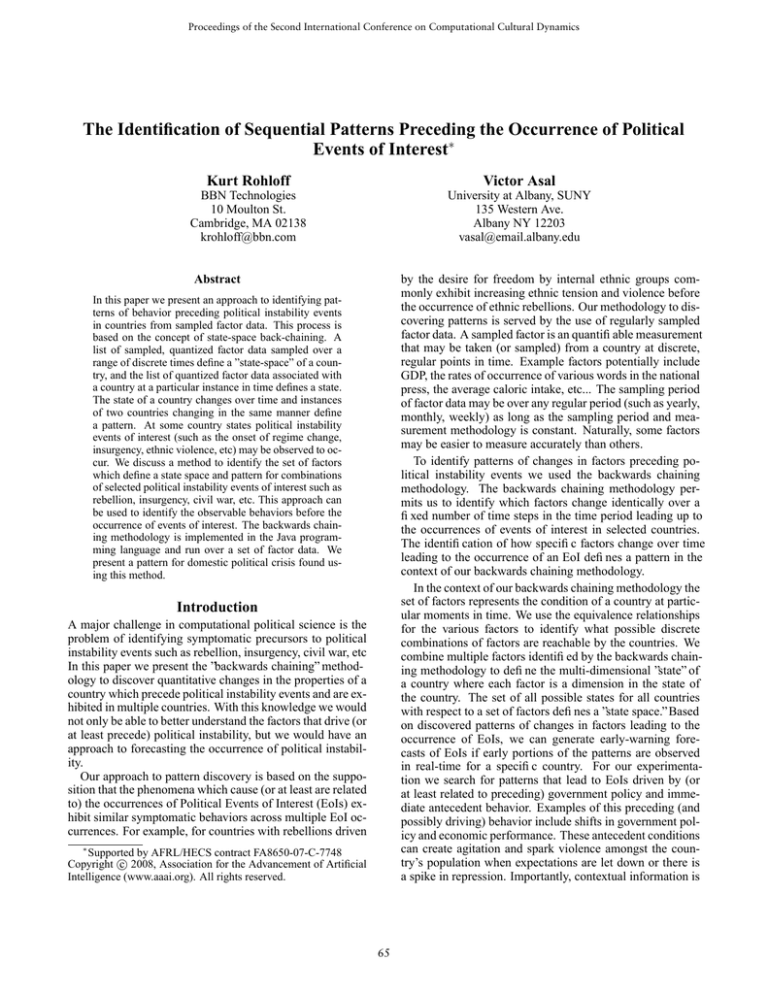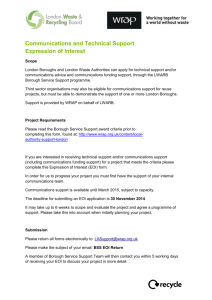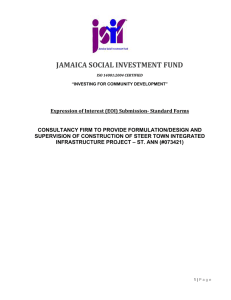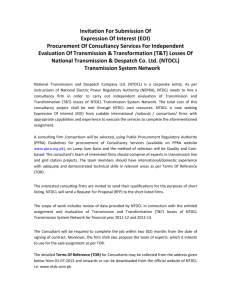
Proceedings of the Second International Conference on Computational Cultural Dynamics
The Identification of Sequential Patterns Preceding the Occurrence of Political
Events of Interest∗
Kurt Rohloff
Victor Asal
BBN Technologies
10 Moulton St.
Cambridge, MA 02138
krohloff@bbn.com
University at Albany, SUNY
135 Western Ave.
Albany NY 12203
vasal@email.albany.edu
Abstract
by the desire for freedom by internal ethnic groups commonly exhibit increasing ethnic tension and violence before
the occurrence of ethnic rebellions. Our methodology to discovering patterns is served by the use of regularly sampled
factor data. A sampled factor is an quantifiable measurement
that may be taken (or sampled) from a country at discrete,
regular points in time. Example factors potentially include
GDP, the rates of occurrence of various words in the national
press, the average caloric intake, etc... The sampling period
of factor data may be over any regular period (such as yearly,
monthly, weekly) as long as the sampling period and measurement methodology is constant. Naturally, some factors
may be easier to measure accurately than others.
To identify patterns of changes in factors preceding political instability events we used the backwards chaining
methodology. The backwards chaining methodology permits us to identify which factors change identically over a
fixed number of time steps in the time period leading up to
the occurrences of events of interest in selected countries.
The identification of how specific factors change over time
leading to the occurrence of an EoI defines a pattern in the
context of our backwards chaining methodology.
In the context of our backwards chaining methodology the
set of factors represents the condition of a country at particular moments in time. We use the equivalence relationships
for the various factors to identify what possible discrete
combinations of factors are reachable by the countries. We
combine multiple factors identified by the backwards chaining methodology to define the multi-dimensional ”state” of
a country where each factor is a dimension in the state of
the country. The set of all possible states for all countries
with respect to a set of factors defines a ”state space.” Based
on discovered patterns of changes in factors leading to the
occurrence of EoIs, we can generate early-warning forecasts of EoIs if early portions of the patterns are observed
in real-time for a specific country. For our experimentation we search for patterns that lead to EoIs driven by (or
at least related to preceding) government policy and immediate antecedent behavior. Examples of this preceding (and
possibly driving) behavior include shifts in government policy and economic performance. These antecedent conditions
can create agitation and spark violence amongst the country’s population when expectations are let down or there is
a spike in repression. Importantly, contextual information is
In this paper we present an approach to identifying patterns of behavior preceding political instability events
in countries from sampled factor data. This process is
based on the concept of state-space back-chaining. A
list of sampled, quantized factor data sampled over a
range of discrete times define a ”state-space” of a country, and the list of quantized factor data associated with
a country at a particular instance in time defines a state.
The state of a country changes over time and instances
of two countries changing in the same manner define
a pattern. At some country states political instability
events of interest (such as the onset of regime change,
insurgency, ethnic violence, etc) may be observed to occur. We discuss a method to identify the set of factors
which define a state space and pattern for combinations
of selected political instability events of interest such as
rebellion, insurgency, civil war, etc. This approach can
be used to identify the observable behaviors before the
occurrence of events of interest. The backwards chaining methodology is implemented in the Java programming language and run over a set of factor data. We
present a pattern for domestic political crisis found using this method.
Introduction
A major challenge in computational political science is the
problem of identifying symptomatic precursors to political
instability events such as rebellion, insurgency, civil war, etc
In this paper we present the ”backwards chaining” methodology to discover quantitative changes in the properties of a
country which precede political instability events and are exhibited in multiple countries. With this knowledge we would
not only be able to better understand the factors that drive (or
at least precede) political instability, but we would have an
approach to forecasting the occurrence of political instability.
Our approach to pattern discovery is based on the supposition that the phenomena which cause (or at least are related
to) the occurrences of Political Events of Interest (EoIs) exhibit similar symptomatic behaviors across multiple EoI occurrences. For example, for countries with rebellions driven
∗
Supported by AFRL/HECS contract FA8650-07-C-7748
c 2008, Association for the Advancement of Artificial
Copyright Intelligence (www.aaai.org). All rights reserved.
65
non-trivial: some factors in a pattern state space might not
change over time, but they set an important context for the
country’s state evolution.
It is also important to note the importance of equifinality
in this analysis as well. A country may or may not follow
multiple patterns leading to EoI occurrence simultaneously,
and there may be multiple means to a same end. For example, a country such as India may contain multiple types of
rebellion or may exhibit the antecedents for several rebellions simultaneously.
This section of the report is organized as follows. Section discusses the theoretical basis for our analysis. Section presents our backwards chaining methodology. Section presents and discusses a pattern discovered with our
methodology and several patterns for insurgency.
variables and across time. From a policy perspective our efforts allow us to identify combinations of changing patterns
of behaviors within particular larger sociopolitical contexts
that are likely, based on past experience to lead to EOI outbreaks at a temporal point distant from the actual outbreak.
Our analytical effort is being driven by an approach that
does not privilege any particular social science theoretical bias related to violent conflict (for example the greed
- grievance argument). Instead we have endeavored to draw
from the best theoretical models we have been able to find
and to operationalize theories in an analytically useful way.
Our efforts are directed at creating a synthesis that draws the
most successful components from each of the three perspectives into a coherent whole that can be used to understand
and predict EoIs. To start with we drew explicitly from the
greed (Collier et al. 2003), grievance(Gurr 2000) , resource
mobilization (McAdam, McCarthy, and Zald 1996), political opportunity structure, (external and demographic) pressures (Tarrow 2001), culture/values (Goldstone 2001)and
leadership literatures (Herman and Herman 1989). In this
effort we are looking to identify factors that help explain
rare events - the outbreak of different kinds of political violence. In general we view EoI emergence, as a product of
interactions between causal factors at different levels of a social environment. Some aspects of that social environment
are more changeable and stochastic while other aspects are
relatively rigid and predictable. These variables combine in
different patterns to produce future behavior-in our case patterns of violence.
In our current analysis we focus on the variables that
change leading up to the EOI’s but we should recognize
that the backward chaining approach we are using allows us
to also identify the ongoing unchanging factors that go into
creating a state space where the changes in particular behavioral and policy factors move a country towards experiencing and EOI. The larger state space of countries primed for
an EOI are defined by elements like general political instability married to anocratic (regimes between democracy and
autocracy) political structures or low levels of militarization.
What we find is that when these types of conditions exist the
stage is set for an EOI. The stage though is not what sparks
the EOI.
Across the different EOI’s we are finding is that a general
decline in good expressions and behavior and a rise in bad
expressions and behaviors - although not as often as we see
the good going down. Certain variables repeat across EOIs
as leading behavioral indicators. Specifically:
A Theoretical Basis for the Pattern Concept
We start our investigation with the belief that the outbreak of
violence will be characterized by equifinality, ”many alternative causal paths to the same outcome (George and Bennett 2005),” in other words there is not one cause of EOI
outbreaks. There may be a set of factors that make those
outbreaks more or less likely but we believe there are a set
of potential causal pathways that are likely to lead to outbreak of non-state actor violence towards the state. We are
interested in exploring the combinational power of various
factors as they lead to EOI’s. To do this we build on efforts
to use Boolean analysis (Ragin 2000) to understand political
activity ” while allowing for ”multiple causal mechanisms
(Chan 2003). Most of this work though starts with collecting data on what is trying to be explained rather then collecting data on both the general environment (the dogs that
don’t bark - and the cats that never would) as well as those
occasions where there is an outbreak of an EOI.
For the backwards chaining process we identify which
factors change in the same manner for several time steps
leading up to all occurrences of a particular EoI. The combination of all of the factors which all change in the same
manner for a fixed number of time steps leading up to all occurrences of a particular EoI define a pattern. By identifying
which specific factors which in combination exhibit symptomatic behavior leading to EoI occurrences, we are closer
to our ongoing goal of obtaining early warning derivative results informed by factor combinatorics in a semi-automated
manner. Our hypothesis is that by identifying such a pattern, one can use this pattern to detect conditions which are
precursors to the occurrences of EoIs and hence have a forecasting capability for EoI occurrence.
It is important to note that a country may or may not follow multiple patterns leading to EoI occurrence simultaneously, and there may be multiple means to a same end. For
example, a country such as India may contain multiple types
of rebellion or may exhibit the antecedents for several rebellions simultaneously.
In our effort to build on Boolean thinking we use the backward chaining approach to go beyond the small n efforts that
have been the focus of most Boolean analysis and to extend
the effort temporally such that we look for patterns across
• The general count of good behavior goes down.
• Efforts at public diplomacy go down.
• Protest behavior tends to go down.
The first two changes are fairly intuitive - good behavior is
an encoding of how often ”good” expressions appeared in
the popular press for a given country over a 1-month time
span. The changes latter may be seen as counterintuitive in
that we can think of protests as a step forward on the continuum of contentious behavior (McAdam, Tarrow, and Tilly
2001). On the other hand if we envision contention as a
66
choice between several kinds of contention (each one exacting a cost) then the withdrawal from a non-violent contention may be a sign that opposition groups are repositioning their resources for more violent approaches and governments are expending resources to drive this behavior down
- perhaps unwittingly pushing opponents into activities that
are much more dangerous. Overall, our approach allows us
to model different patterns of change within a broader unchanging state space that leads to violence.
observed in real-time for a specific country. Although we
are discovering patterns using training factor data inside the
AOR, the patterns can be used to forecast EoI occurrences
outside of the AOR.
In general, we search for patterns that lead to EoIs driven
by (or at least related to preceding) government policy and
immediate antecedent behavior. Examples of this preceding (and possibly driving) behavior include shifts in government policy and economic performance. These antecedent
conditions can create agitation and spark violence amongst
the country’s population when expectations are let down or
there is a spike in repression. It is important to note that we
are searching for and forecasting on factors acting in combination and over time which cause the advent of events of
interest. Contextual information is non-trivial: some factors
in a pattern state space might not change over time, but they
set an important context for the country’s state evolution.
An overview of our process of identifying factors for a
pattern are as follows: (We describe these steps in detail below.)
The Backwards Chaining Methodology
In this section we present our methodology for automatically discovering patterns based on the backwards chaining methodology process. We implemented this process in
the Java programming language to automatically obtain data
from a data server, search over the data in an automated manner to identify key factor changes that precede selected EoIs
to identify patterns.
To discover patterns using the backwards chaining
methodology we developed algorithms and wrote software
to identify factors that change ”identically” over a fixed
number of sample times in the time period leading up to
the occurrences of user-selected EoI advents. We define
an equivalence relationship for the factor values based on
quantization levels of those factors that was implemented in
our factor identification tool. We use that equivalence relationship to determine when changes in factors are similar
enough to be called ”identical”.
For the backwards chaining methodology, we define a pattern for the advent of an EoI to be:
1. A set of factors, and
2. A description on how each of those factors change quantitatively a fixed number of time steps before the advent
of an Event of Interest in at least two distinct instances.
The set of factors which define a pattern may include a factor
that represents previous occurrences of the advent of the EoI
itself.
An example of a hypothetical identification of two factors
that change identically in the time preceding the occurrence
of an EoI is seen in Figure 1. This figure shows the values of
two factors (quality of government and level of corruption)
for two countries for several quarters preceding the occurrence of the EoI rebellion. The trajectory of one country
is shown using a black line and the trajectory of a second
country is shown using a light blue line. In this example,
the values of the Quality of Government and Corruption are
nearly the same for up to three quarters before the occurrence of Rebellion. Although in all of the pattern examples
we discuss in this paper are derived from behaviors in two
different countries at two different times, our patterns could
be derived from the behavior of two different countries at the
same time or even the same country at two different times.
In the context of our backwards chaining methodology,
the set of factors that define a pattern represents the specific aspects of the condition of a country at particular moments in time. Based on discovered patterns of changes in
factors leading to the advent of EoIs, we can generate earlywarning forecasts of EoIs if early portions of the patterns are
1. Identify EoI occurrences for which patterns should be
identified.
2. Quantize Factor Data.
3. Determine which factors are identical for all instances for
a user-specified number of times steps before EoI occurrence.
This process is presented graphically in Figure 2.
We now discuss this process in more detail:
Identify EoI advents for which patterns should be
identified.
This step is used to identify the primary operational input to
the backwards chaining process in addition to the factor data.
We use our backwards chaining approach for sequential pattern identification with the understanding that not all EoI advents of the same type are driven by the same underlining
Figure 1: The identification of factors leading to an EoI.
67
process. (For example, international crises may be driven by
ethnic divisions, resource contention or any other number of
driving forces.) This step is primarily a user-driven process
to select countries and times where interesting patterns are
most likely to be found. One of our main hypotheses is that
if we attempted to identify patterns using unrelated EoI advents as input, then we would not find meaningful patterns,
if we were to find any patterns at all.
over time. If we were to quantize the factor data using only
the factor values that define the EoIs, the factor quantizations
would be skewed to those countries.
Determine which factors are identical for all
instances for a user-specified number of times steps
before EoI occurrence.
In order to process the factor data to identify what factors
change identically for a number of time steps preceding an
EoI, from set of raw factor data for each country, we create two quantized factors. One quantized factor is a straight
linear quantization of the raw factor data, and a second quantized factor is a linear quantization of the natural logarithm
of the raw factor data. The process of creating two sets of
quantized factor data from one raw factor is shown in Figure
3.
Although the straight linear quantization factors provide
an indication of the relative value of a factor changes over
time, this approach cannot easily account for order-ofmagnitude variations in factor values from country to country or from time to time. We use the logarithmic quantization
because provides an indication of how the order of magnitude of a factor value changes over time.
To generate the logarithmic factor data from the source
factor data we used the natural logarithm function in Java.
When factors contain data that was undefined for the natural logarithm operation (such as when the factor data was
less than or equal to zero), we did not use the logarithmic
quantization of that factor.
For our initial experiments we obtained multiple meaningful results with factor data that was automatically quantized to either 3, 4 and 5 quantization levels for our experimentation factor data. Note that we use all of the factor data
to perform the quantization operation to ensure that we have
a sufficiently broad view of how the various factors change
For each EoI advent selected by the user to construct the pattern we identify on an automated quantized factor by quantized factor basis which of the factors have identical values
for a user-defined number of time steps before the advent of
the EoI in the countries where the EoIs occurred. These collections of factors and how they change over time leading up
to the occurrence of an EoI define a pattern.
We list the patterns we found in a later section and on our
web site, but in the next subsection we present and discuss
a representative pattern we found through our backwards
chaining process.
As a preliminary validation of the factors that we found,
we tested to see if any countries in the test data AOR have
identical historical values such that they match exactly the
factors in our patterns. We implemented this functionality in
the Java programming language to take discovered patterns
and automatically test if any countries in the test data over
any date range that we have factor data for matches the pattern. If any country matches the factor values, but there was
no EoI present in the country for the period immediately after the pattern match, then we declared that the pattern had
a ”false alarm”. In general we found that there were very
few or no false alarms in our discovered patterns. In the
discovered patterns that were output by our automated pattern discovery process there is generally a large number of
factors which are identical in the time leading up to the advent of EoIs, but a relatively small number of factors which
change over time preceding the EoIs. We hypothesized that
the changing factors are symptomatic predecessors of the
EoIs and the constant factors are either contextual information for the changing factors to precede the advent of the EoI
Figure 2: The Pattern Identification Concept of Operations.
Figure 3: The Data Quantization Process.
Quantize Factor Data.
68
or they are extraneous information. To identify the necessary constant contextual factors in our patterns and remove
the extraneous constant factors in our patterns, we repeatedly and randomly removed constant factors from the pattern that does not decrease the false alarm rate. We repeated
this process many times to find an approximation to the minimal number of constant factors needed to define a pattern
for the defining EoIs with a low false alarm rate.
contextual variables.
References
Chan, S. 2003. Explaining war termination: A boolean
analysis of causes. Journal of Peace Research 40(1):49–
66.
Collier, P.; Elliott, L.; Hegre, H.; Hoeffler, A.; ReynalQuerrol, M.; and Sambanis, N. 2003. Breaking the Conflict
Trap: Civil War and Development Policy. Oxford: World
Bank and Oxford University Press.
George, A. L., and Bennett, A. 2005. Case Studies and
Theory Development in the Social Sciences. Boston: The
MIT Press.
Goldstone, J. A. 2001. Toward a fourth generation of
revolutionary theory. Annual Review of Political Science
4(1):139–187.
Gurr, T. R. 2000. People vs. States. Washington D.C.:
United States Institute of Peace.
Herman, M. G., and Herman, C. F. 1989. Who makes
foreign policy decisions and how: An empirical inquiry.
International Studies Quarterly 33(4):361–387.
McAdam, D.; McCarthy, J. D.; and Zald, M. N. 1996.
Comparative perspectives on social movements : political
opportunities, mobilizing structures, and cultural framings.
Cambridge, New York: Cambridge University Press.
McAdam, D.; Tarrow, S.; and Tilly, C. 2001. Dynamics of
Contention. Cambridge: Cambridge University Press.
Ragin, C. C. 2000. Fuzzy-set social science. University of
Chicago Press.
Tarrow, S. 2001. Transnational politics: Contention and
institutions in international politics. Annual Review of Political Science 4(1):1–20.
Patterns Discovered Using Operational Data
We now discuss representative results of our pattern search
and present several patterns. For our factor data we used
a combination of data from the QoG compilation imputed
monthly and additional in-house factor data derived from
counting the occurrences of certain words in news-feeds.
When analyzing the quantized factors selected through the
back-chaining methodology to define a pattern, we generally see that a decline of the good expressions and behaviors
are leading many of the advents and the rise of bad expressions in the public press and behaviors are as well- although
not as often as we see the good going down. Our use of
the terminology ”low, moderate, high”, etc is used to indicate the relative quantization level of the factor at the various
time steps. This information is in a sense redundant because
we use numeric indications of quantization level (0, 1, 2, ),
but we included the qualitative indicators because it may not
always be clear what the numeric levels represent due to the
varying quantization levels across patterns.
Our first example (which can be seen below in Table 1)
is one that looks at the advent of Domestic Political Crisis
(DPC) using a three-level quantization. It is based on advents of DPC in Malaysia in Jan, 1999 and Nepal in May,
1998. The general context is a moderate (but not low) level
of militarized non-state actors as a function of the total number of non-state actors (NSA) within the framework of an
autocratic country. As we mentioned above (and this DPC
result is a classic example of this) what we are seeing is the
rise of bad expressions and behavior as captured in our count
or bad ”words and actions” and a decline in a similar measure for good ”words and actions.”
Turning our attention to other patterns we found for insurgencies (Tables 2 thru 4) we offer examples that are at
different quantization levels and based on different combinations of cases that tell related but different stories about
when violence is likely to break out. In the Table 2 pattern
we see a clear example of the fall of good ”words” combined
with problematic contexts (like high instability combined
with very low militarization) can lead to wide scale organized violence. Using a different quantization but building
on the same countries we see a different twist to the story.
Protests fall from high to moderate. This may be an indication of a switch of strategies on the part of opposition forces
as the reposition their resources to more violent means. Note
that this still in the context of low or dropping (depending on
how measured) counts of general good ”words and actions.”
The pattern in Table 3 uses one different country and several
different variables tells a similar story about falling good action and statements while the pattern in Table 4 again identifies a fall in protest as a clear danger sign given the right
69
Table 1: DPC for Malaysia in Jan, 1999 and Nepal in May, 1998 Quantization Level 3
Factor
Tension bad/count
Tension good/count
Polity 2
Militarized nsa/nsa
Quantization
Method
Linear
Linear
Linear
Linear
DPC onset t-3
DPC onset t-2
DPC onset t-1
0-low
2-high
0-low
1-moderate
1-moderate
2-high
0-low
1-moderate
1-moderate
1-moderate
0-low
1-moderate
Table 2: Insurgency for Indonesia Jan., 2001, Malaysia August 2001 Quantization Level 3
Factor
Tension good
Public statements
Tension goods/count
Political globalization
Good/Tokens
milpertpop
Log Polcon
Instabl
Quantization
Method
Log
Log
Linear
Linear
Linear
Linear
Log
Linear
Insurgency onset t-3
Insurgency onset t-2
Insurgency onset t-1
2-high
2-high
0-low
2-high
0-low
0-low
2-high
2-high
1-moderate
1-moderate
0-low
2-high
0-low
0-low
2-high
2-high
1-moderate
1-moderate
0-low
2-high
0-low
0-low
2-high
2-high
Table 3: Insurgency for Indonesia Jan., 2001, Malaysia August 2001 Quantization Level 5
Factor
Protest
Anti-market regulatory quality
Tension goods/count
Log investigate
Quantization
Method
Log
Log
Linear
Log
Insurgency onset t-3
Insurgency onset t-2
Insurgency onset t-1
3-high
4-very high
1-low
2-moderate
2-moderate
4-very high
1-low
2-moderate
2-moderate
3-high
1-low
2-moderate
Table 4: Insurgency for Indonesia May., 2003, Thailand Jan., 2004 Quantization Level 3
Factor
Tension good
Public Statements
Diplomatic cooperation
Political Constraints
Percent of neighbors democratic
Religious fractionalization
Political Rights
Quantization
Method
Log
Linear
Linear
Linear
Linear
Linear
Linear
Insurgency onset t-3
Insurgency onset t-2
Insurgency onset t-1
2-high
2-high
2-high
1-moderate
0-low
0-low
1-moderate
1-moderate
1-moderate
1-moderate
1-moderate
0-low
0-low
1-moderate
1-moderate
1-moderate
1-moderate
1-moderate
0-low
0-low
1-moderate
Table 5: Insurgency for Laos Feb., 2003, Thailand Jan., 2004 Quantization Level 3
Factor
Protest Behaviors
Distrust/bad
bad/tokens
Linguistic Fractionalization
Physical Integrity Rights
Quantization
Method
Log
Log
Linear
Linear
Linear
Insurgency onset t-3
Insurgency onset t-2
Insurgency onset t-1
1-moderate
2-high
0-low
2-high
1-moderate
1-moderate
1-moderate
0-low
2-high
1-moderate
0-low
1-moderate
0-low
2-high
1-moderate
70
ICCCD 2008
Proceedings
This paper was published in the Proceedings of the Second International Conference on
Computational Cultural Dynamics, edited by V. S. Subrahmanian and Arie Kruglanski
(Menlo Park, California: AAAI Press).
The 2008 ICCCD conference was held at the University of Maryland, College Park,
Maryland, USA, 15–16 September, 2008.





